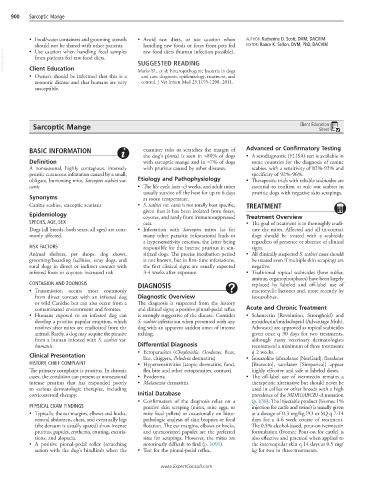Page 1795 - Cote clinical veterinary advisor dogs and cats 4th
P. 1795
900 Sarcoptic Mange
• Food/water containers and grooming utensils • Avoid raw diets, or use caution when AUTHOR: Katherine D. Scott, DVM, DACVIM
should not be shared with other patients. handling raw foods or feces from pets fed EDITOR: Rance K. Sellon, DVM, PhD, DACVIM
VetBooks.ir Client Education SUGGESTED READING
raw food diets (human infection possible).
• Use caution when handling fecal samples
from patients fed raw food diets.
• Owners should be informed that this is a Marks SL, et al: Enteropathogenic bacteria in dogs
and cats: diagnosis, epidemiology, treatment, and
zoonotic disease and that humans are very control. J Vet Intern Med 25:1195-1208, 2011.
susceptible.
Sarcoptic Mange Client Education
Sheet
BASIC INFORMATION examiner rubs or scratches the margin of Advanced or Confirmatory Testing
the dog’s pinna) is seen in ≈80% of dogs • A serodiagnostic (ELISA) test is available in
Definition with sarcoptic mange and in ≈7% of dogs some countries for the diagnosis of canine
A nonseasonal, highly contagious, intensely with pruritus caused by other diseases. scabies, with a sensitivity of 82%-92% and
pruritic cutaneous infestation caused by a small, specificity of 92%-96%.
obligate, burrowing mite, Sarcoptes scabiei var. Etiology and Pathophysiology • Therapeutic trials with reliable scabicides are
canis • The life cycle lasts ≈3 weeks, and adult mites essential to confirm or rule out scabies in
usually survive off the host for up to 6 days pruritic dogs with negative skin scrapings.
Synonyms at room temperature.
Canine scabies, sarcoptic acariasis • S. scabiei var. canis is not totally host specific, TREATMENT
given that it has been isolated from foxes,
Epidemiology coyotes, and rarely from immunosuppressed Treatment Overview
SPECIES, AGE, SEX cats. • The goal of treatment is to thoroughly eradi-
Dogs (all breeds, both sexes, all ages) are com- • Infestation with Sarcoptes mites (as for cate the mites. Affected and all in-contact
monly affected. many other parasitic infestations) leads to dogs should be treated with a scabicide
a hypersensitivity reaction, the latter being regardless of presence or absence of clinical
RISK FACTORS responsible for the intense pruritus in sen- signs.
Animal shelters, pet shops, dog shows, sitized dogs. The precise incubation period • All clinically suspected S. scabiei cases should
grooming/boarding facilities, stray dogs, and is not known, but in first-time infestations, be treated even if multiple skin scrapings are
rural dogs in direct or indirect contact with the first clinical signs are usually expected negative.
infested foxes or coyotes: increased risk 3-4 weeks after exposure. • Traditional topical scabicides (lime sulfur,
amitraz, organophosphates) have been largely
CONTAGION AND ZOONOSIS DIAGNOSIS replaced by labeled and off-label use of
• Transmission occurs most commonly macrocyclic lactones and, more recently by
from direct contact with an infested dog Diagnostic Overview isoxazolines.
or wild Canidae but can also occur from a The diagnosis is suspected from the history
contaminated environment and fomites. and clinical signs; a positive pinnal-pedal reflex Acute and Chronic Treatment
• Humans exposed to an infested dog can is strongly suggestive of the disease. Consider • Selamectin (Revolution, Stronghold) and
develop a pruritic papular eruption, which S. scabiei infestation when presented with any moxidectin/imidacloprid (Advantage Multi,
resolves after mites are eradicated from the dog with an apparent sudden onset of intense Advocate) are approved as topical scabicides
animal. Rarely, a dog may acquire the parasite itching. given once q 30 days for two treatments,
from a human infested with S. scabiei var. although many veterinary dermatologists
humanis. Differential Diagnosis recommend a minimum of three treatments
• Ectoparasites (Cheyletiella, Otodectes, fleas, q 2 weeks.
Clinical Presentation lice, chiggers, Pelodera dermatitis) • Isoxazoline (afoxolaner [NexGard], fluralaner
HISTORY, CHIEF COMPLAINT • Hypersensitivities (atopic dermatitis, food, [Bravecto], sarolaner [Simparica]) appear
The primary complaint is pruritus. In chronic flea bite and other ectoparasites, contact) highly effective and safe at labeled doses.
cases, the condition can present as nonseasonal • Pyoderma • The off-label use of ivermectin remains a
intense pruritus that has responded poorly • Malassezia dermatitis therapeutic alternative but should never be
to various dermatologic therapies, including used in collies or other breeds with a high
corticosteroid therapy. Initial Database prevalence of the MDR1/ABCB1-Δ mutation
• Confirmation of the diagnosis relies on a (p. 638). The injectable product (Ivomec 1%
PHYSICAL EXAM FINDINGS positive skin scraping (mites, mite eggs, or injection for cattle and swine) is usually given
• Typically, the ear margins, elbows and hocks, mite fecal pellets) or occasionally on histo- at a dosage of 0.3 mg/kg PO or SQ q 7-14
ventral abdomen, chest, and eventually legs pathologic analysis of skin biopsies or fecal days for a 4-6 week course of treatment.
(the dorsum is usually spared) show intense flotation. The ear margins, elbows or hocks, The 0.5% alcohol-based, pour-on ivermectin
pruritus, papules, erythema, crusting, excoria- and unexcoriated papules are the preferred formulation (Ivomec Pour-on for cattle) is
tions, and alopecia. sites for scrapings. However, the mites are also effective and practical when applied to
• A positive pinnal-pedal reflex (scratching notoriously difficult to find (p. 1091). the interscapular skin q 14 days at 0.5 mg/
action with the dog’s hindlimb when the • Test for the pinnal-pedal reflex. kg for two to three treatments.
www.ExpertConsult.com

